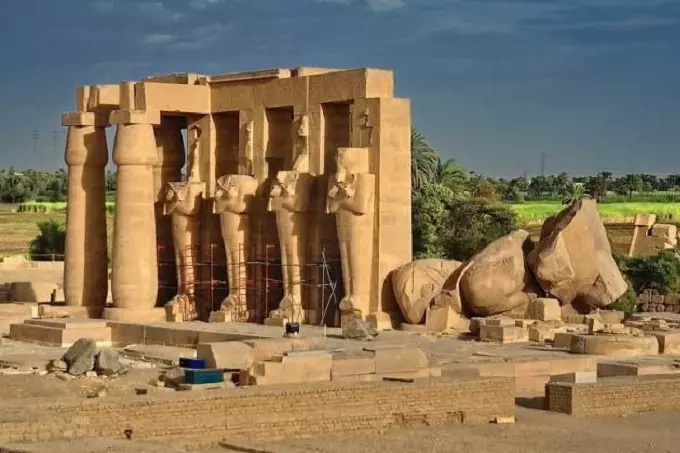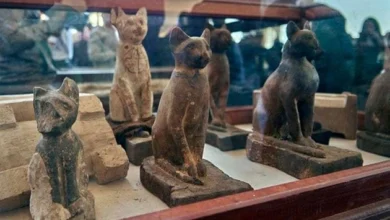Secrets of Ancient Egyptian statues

The lack of the necessary high-precision equipment with which numerous ancient Egyptian artifacts could be created, as well as the absence of traces of industrial infrastructure for its production in Egypt and beyond, indicate that high technology was introduced from the outside. And here, it would not be bad to recall the mythological plot common among various peoples about the “sons of heaven” who, after completing a certain humanitarian mission on Earth, return to “their star”.
At the turn of the III millennium BC in Egypt, an inexplicable technological breakthrough occurred almost from scratch. As if by magic, in an extremely short time, the Egyptians erected pyramids and demonstrated unprecedented skill in processing hard materials – granite, diorite, obsidian, quartz…
All these miracles happened before the advent of iron, machine, and other technical tools. Subsequently, the unique skills of the ancient Egyptians disappear just as rapidly and inexplicably…
Strange neighborhood
Take, for example, the story of the Egyptian sarcophagi. They are divided into two groups, which are strikingly different in the quality of execution. On the one hand, carelessly made boxes, in which uneven surfaces predominate. On the other hand, multi-ton granite and quartzite containers of unknown purpose are polished with incredible skill. Often, the quality of processing of these sarcophagi is at the limit of modern machine technologies.
Ancient Egyptian sculptures made of heavy-duty materials are no less a mystery. In the Egyptian Museum, anyone can see a statue carved from a single piece of black diorite. The surface of the statue is polished to a mirror shine. Scientists suggest that it belongs to the period of the Fourth Dynasty (2639-2506 BC) and depicts the Pharaoh Khafra, who is credited with the construction of one of the three largest pyramids of Giza.

But here’s the problem – in those days, Egyptian craftsmen used only stone and copper tools. Soft limestone can still be processed with such tools, but diorite, which is one of the hardest rocks, well, it is impossible.
And these are still flowers. But the colossi of Memnon, located on the west bank of the Nile, opposite Luxor, are already berries. Not only are they made of heavy-duty quartzite, but their height also reaches 18 meters, and the weight of each statue is 750 tons.
In addition, they rest on a 500-ton quartzite pedestal! It is clear that no transportation devices could withstand such a load. Although the statues are badly damaged, the excellent execution of the surviving flat surfaces suggests the use of advanced machine technologies.
But even the greatness of the colossi pales in comparison with the fragments of a giant statue resting in the courtyard of the Ramesseum – the memorial temple of Ramesses II, made from a single piece of pink granite, the sculpture reached a height of 19 meters and weighed about 1,000 tons! The weight of the pedestal on which the statue once stood was about 750 tons. The monstrous size of the statue and the highest quality of execution absolutely do not fit into the technological capabilities of Egypt known to us during the New Kingdom period (1550-1070 BC), which modern science dates the sculpture.
But the Ramesseum itself fully corresponds to the technical level of that time: statues and temple buildings are created mainly from soft limestone and do not shine with building delights.
We observe the same picture with the colossi of Memnon, whose age is determined by the remains of the memorial temple located behind them. As in the case of the Ramesseum, the quality of this structure, to put it mildly, does not shine with high technology – unfired brick and roughly fitted limestone, that’s all the masonry.
Such an incongruous neighborhood can only be explained by the fact that the Pharaohs simply attached their temple complexes to monuments left over from another, much more ancient and highly developed civilization.
The eyes of the statue
Another mystery is connected with the ancient Egyptian statues. We are talking about eyes made of pieces of rock crystal, which were inserted, as a rule, into limestone or wooden sculptures. The quality of the lenses is so high that thoughts about lathes and grinding machines come by themselves.

The eyes of the wooden statue of Pharaoh Khor, like the eyes of a living person, look blue or gray depending on the angle of illumination and even imitate the capillary structure of the retina! A study by Professor Jay Enoch from the University of Berkeley showed the amazing proximity of these glass models to the shape and optical properties of the real eye.

The American researcher believes that Egypt achieved the greatest mastery in lens processing by about 2500 BC. After that, for some reason, such a wonderful technology ceases to be used and is subsequently forgotten altogether. The only reasonable explanation is that the Egyptians borrowed quartz blanks for eye models from somewhere, and when the reserves ran out, the “technology” was interrupted.
What did the gods look like?
The ancient Greek historian Diodorus Siculus wrote, that according to the Egyptian priests, mortals ruled Egypt for less than 5 millennia. The kingdom of men was preceded by the power of gods and heroes who ruled for an incredible 18 thousand years. The ancient Egyptian priest and historian Manetho also begins his list of rulers of Egypt with a dynasty of gods and demigods.
If we compare the statements of ancient authors and the facts that we have at the moment, it turns out that there was no technological breakthrough. It’s just that starting from the III millennium BC, artifacts left over from the first divine dynasties began to surface in Egypt. It is possible that the Pharaohs purposefully searched, tried to master, and simultaneously appropriate the preserved fragments of this heritage.
Sculptural images of the daughters of the reformer Pharaoh Akhenaten can tell about the appearance of the original creators of ancient masterpieces. The first thing that catches the eye is the unnaturally elongated shape of the skull, which, by the way, is characteristic of other works of the Amarna period. This phenomenon gave rise to the hypothesis of congenital disease in the Pharaoh’s family. However, there is no mention of any mental abnormalities in the ruler’s family that such a disease must inevitably cause.

If the pharaohs were indeed distant descendants of the gods, it is possible that from time to time, they could manifest “divine” genes. Is it not with this anatomical feature of the gods that the custom of deforming the head, common among various peoples, is connected?
Another important and mysterious detail of the ancient Egyptian sculptural canon is the absolute symmetry of the proportions of the face. As you know, there are no symmetrical objects in nature. This rule also applies to the human body. Moreover, experiments have shown that photographs made up of strictly symmetrical halves of the same face cause an instinctive rejection in a person.
There is something unnatural and alien to human nature in them. But maybe in the world from which the gods came, other natural conditions reigned, thanks to which the “anomaly” became the norm. Be that as it may, we should carefully listen to the words of Plutarch: “It is not the one who denies the existence of the gods who falls into greater blasphemy, but the one who recognizes them as the superstitious consider them to be.”




